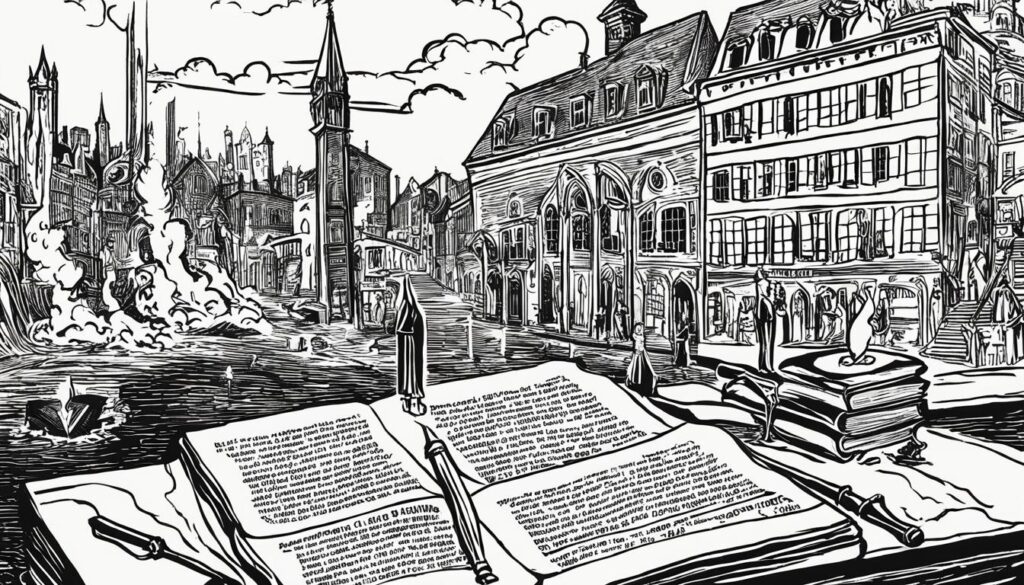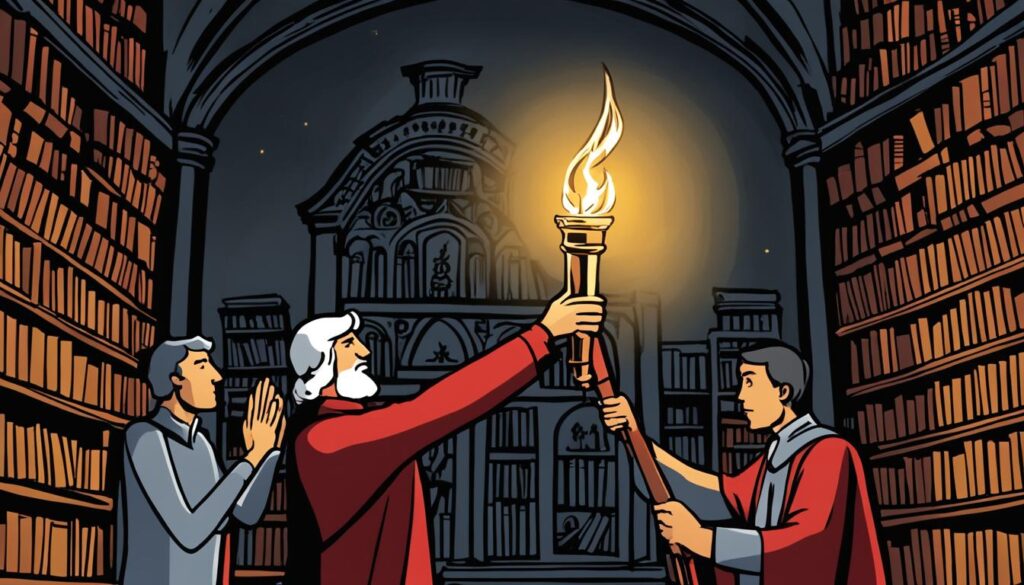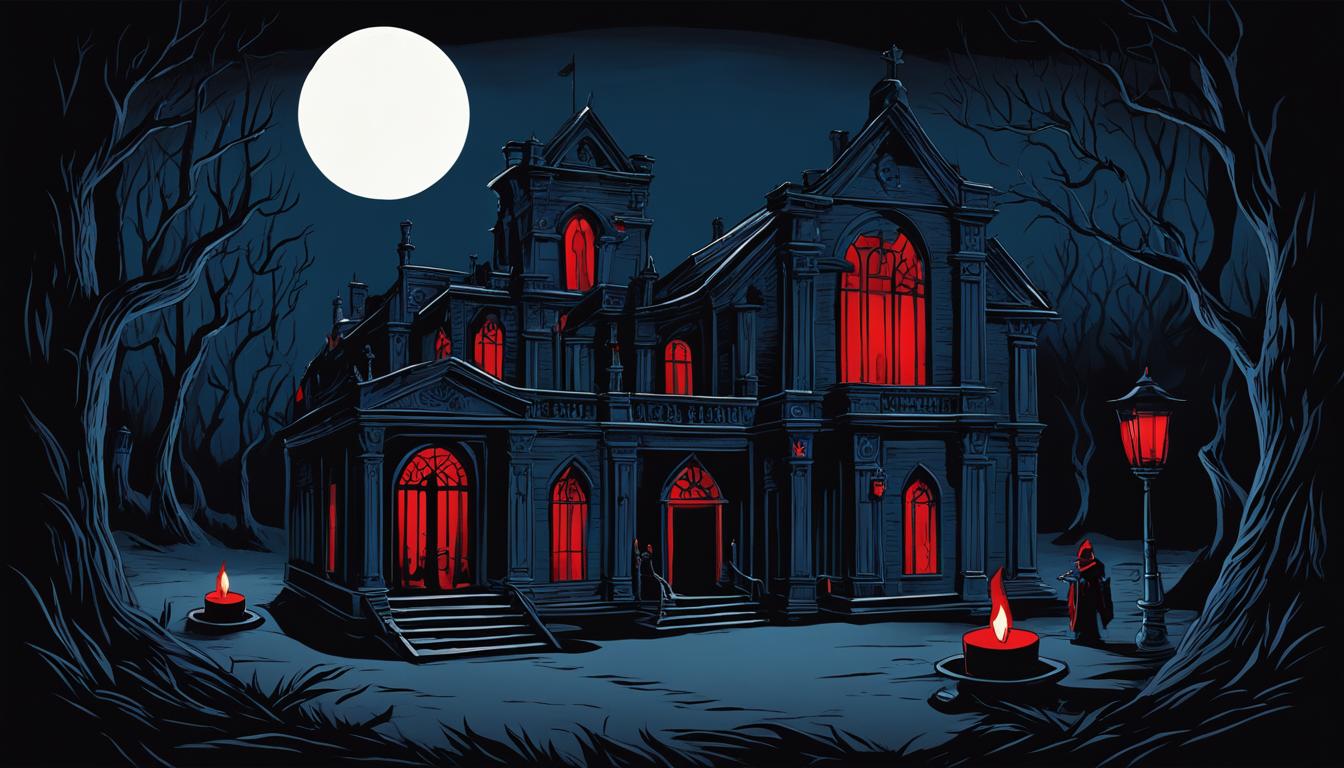The Dante Club by Matthew Pearl is a historical fiction and mystery novel that combines a host of literary figures with the renowned work of Dante’s Comedy. The story revolves around a group of literary luminaries in 1865 Boston, including Henry Wadsworth Longfellow, Dr. Oliver Wendell Holmes, and James Russell Lowell, who are translating Dante’s works into English. However, their translation project is interrupted by a series of murders that mimic punishments from Dante’s Inferno. This debut novel by Matthew Pearl explores the challenges and dangers faced by the Dante Club as they navigate the literary and political landscape of post-Civil War Boston.
Key Takeaways:
- The Dante Club is a historical fiction and mystery novel set in post-Civil War Boston.
- The novel revolves around a group of literary luminaries who are translating Dante’s works into English.
- A series of murders that mimic punishments from Dante’s Inferno interrupt their translation project.
- The book explores themes of literature, crime, loyalty, and justice in the context of 19th-century America.
- Matthew Pearl’s debut novel combines historical accuracy with suspense and richly descriptive prose.
The Plot and Setting of The Dante Club
The Dante Club, set in 1865 Boston, introduces readers to a group of literary figures who are members of the Dante Club, a dedicated community translating Dante’s works into English. Against the backdrop of post-Civil War Boston, the novel explores the political and literary challenges faced by the club. However, the tranquil pursuit of translation is disrupted by a series of murders that mimic the punishments detailed in Dante’s Inferno.
The plot revolves around the members of the Dante Club as they uncover connections between the murders and Dante’s work. Racing against time, they must stop the killer and protect the reputation of Dante’s haunting writings. The setting of post-Civil War Boston adds depth and complexity to the story, reflecting the societal and cultural landscape of the time.
“In that case,” said my friend, tossing aside his manuscript, “I’m reprinting Inferno.”
As the members of the Dante Club delve deeper into the investigation, they find themselves on a perilous path, balancing the pursuit of truth and justice with their own lives. The blending of historical context, literary references, and the suspenseful plot creates a compelling narrative that keeps readers engaged from start to finish.
Throughout the novel, Matthew Pearl masterfully weaves together the elements of plot and setting, transporting readers to a vividly rendered world that echoes the beauty and darkness of Dante’s timeless masterpiece.
Image: The visual representation illustrates the mysterious and atmospheric setting of 1865 Boston, the backdrop for the plot of The Dante Club.
The Characters of The Dante Club
The Dante Club introduces a diverse cast of historical and fictional characters, each playing a vital role in unraveling the mysteries and protecting the reputation of Dante’s work. These characters bring depth and intrigue to the narrative, showcasing the talent and determination of their respective roles.
- Henry Wadsworth Longfellow: A renowned poet and the leader of the Dante Club, Longfellow is instrumental in the translation of Dante’s works into English. His passion for literature and his leadership skills drive the club’s pursuit of Dante’s legacy.
- Dr. Oliver Wendell Holmes: A doctor and poet, Holmes is a member of the Dante Club and contributes his medical expertise to the investigation of the murders. His analytical mind and sharp intuition aid in deciphering the intricate web of clues.
- James Russell Lowell: A prominent poet and the first member of the Dante Club, Lowell brings his literary prowess and dedication to the translation project. His insights and connections prove invaluable in uncovering the truth behind the murders.
- Nicholas Rey: The first African-American policeman in Boston, Rey provides a unique perspective and experiences the prejudices of society firsthand. His determination to seek justice and prove his worth adds depth and social commentary to the story.
- Chief Kurtz: The head of the police force, Kurtz is tasked with solving the mysterious murders plaguing Boston. With his authoritative presence and unwavering commitment to justice, he navigates the complex political and social dynamics of the city.
The Dante Club also features various victims and suspects, each adding layers of intrigue and suspense to the story. From the intriguing characters’ interactions, their struggles, and their pursuit of truth, readers are taken on a thrilling journey through the dark underbelly of post-Civil War Boston.
“The characters in The Dante Club are a captivating mix of historical and fictional figures. From the leaders of the Dante Club to the police force, each character brings their own unique contribution to the investigation and the overall narrative. Matthew Pearl skillfully weaves together their stories, creating a rich tapestry of relationships and motivations. Readers will be engrossed in the lives and exploits of these characters as they work to unravel the mysteries surrounding Dante’s work and the gruesome murders.”
The Themes in The Dante Club
The Dante Club explores several themes throughout the novel. One prominent theme is the power of literature and the influence it can have on society. The members of the Dante Club believe in the importance of translating Dante’s works to bring them to a wider audience and challenge the conservative beliefs of the Boston elite.
Another theme is the intersection of art and crime, as the murders in the novel are inspired by Dante’s punishments in Inferno. The novel also touches on themes of loyalty, betrayal, and the pursuit of justice.
The Historical Context of The Dante Club
The Dante Club is set in post-Civil War Boston, providing a vivid portrayal of the city and its social, political, and cultural climate. The novel touches on the aftermath of the war, exploring the challenges faced by demobilized and discarded union soldiers. Additionally, the story highlights the academic hegemony of Harvard University and the rivalry between Boston and New York in the publishing industry.
The historical context adds depth and richness to the story, offering readers a glimpse into the challenges and complexities of life during this period in American history. It brings to the forefront the impact of the war on the city’s landscape, the struggles of marginalized individuals, and the tensions between rival cities in the literary world.

The Literary Significance of The Dante Club
The Dante Club goes beyond being just a gripping mystery novel. It holds immense literary significance as a work of historical fiction that seamlessly integrates real-life literary figures and their works into the narrative. Author Matthew Pearl, a renowned Dante scholar himself, skillfully combines fact and fiction as he delves into the lives and writings of noteworthy literary luminaries like Henry Wadsworth Longfellow, Oliver Wendell Holmes, James Russell Lowell, and other members of the Dante Club.
Beyond its fascinating characters and enthralling plot, The Dante Club sheds light on the translation of Dante’s works into English and the challenges faced by the literary elite in promoting foreign literature in America during the post-Civil War era. Through the novel, readers gain insights into the influential role that literature played in shaping society and inspiring change. It serves as a testament to the enduring power of literature to transcend time and influence the collective imagination of generations.
The Writing Style of Matthew Pearl
Matthew Pearl, an acclaimed author known for his historical fiction and mystery novels, possesses a unique writing style that seamlessly blends historical accuracy with elements of suspense and mystery. His prose is captivating and vividly descriptive, allowing readers to immerse themselves in the richly depicted setting and deeply developed characters of his narratives.
Pearl’s deep knowledge and passion for literature shine through in his portrayal of the Dante Club, a group dedicated to translating Dante’s works, and their unwavering commitment to their task. His attention to detail and meticulous research add depth and authenticity to the story, transporting readers to the bustling streets of 19th-century Boston and the literary realm of the Dante Club.
“The beauty of literature lies in the ability to transport readers to different times and places. Matthew Pearl’s writing accomplishes just that, immersing readers in a world of historical significance and intrigue.” – Book Critic
With every page, Pearl’s writing instills a sense of anticipation and urgency, compelling readers to turn each page in search of answers. His skillful storytelling keeps readers captivated from start to finish, making his novels a delightful blend of literary exploration and thrilling suspense.
Imagery and Atmosphere
Pearl’s writing style is characterized by its powerful imagery and the creation of a palpable atmosphere. Through skillful prose, he paints vivid pictures of the settings, enabling readers to feel fully immersed in the world he has crafted. From the dark and mysterious streets of Boston to the intellectual and literary gatherings of the Dante Club, Pearl’s words bring each scene to life.
Suspense and Tension
One of the hallmarks of Pearl’s writing style is his ability to build suspense and tension throughout his novels. He expertly crafts intricate mysteries and suspenseful plots, keeping readers on the edge of their seats. With each revelation and plot twist, Pearl’s writing style ensures that the suspense remains palpable, driving the narrative forward and leaving readers eager for more.
- Impeccable attention to historical accuracy
- Seamless integration of literary references
- Strong command of narrative pacing
- Engaging and well-rounded characters
Overall, Matthew Pearl’s writing style is a testament to his expertise as a historical fiction and mystery author. His ability to seamlessly blend historical accuracy, suspense, and vivid imagery creates an immersive reading experience that keeps readers eagerly turning the pages.
The Critical Reception of The Dante Club
The Dante Club, upon its release, received widespread critical acclaim. The novel’s intriguing blend of historical fiction and mystery captivated readers and propelled it to the top of several bestseller lists.
Matthew Pearl’s exceptional writing skills were lauded by reviewers, who praised his ability to bring historical figures to life and his talent for crafting a suspenseful and engaging plot. The Dante Club was described as audacious, captivating, and accomplished, with a unique premise that kept readers on the edge of their seats.
“A true literary gem that seamlessly weaves fact and fiction, The Dante Club skillfully transports readers back to post-Civil War Boston,” remarked one critic.
Reviewers also commended the novel for its insightful portrayal of the historical and cultural context of post-Civil War Boston. The meticulous attention to detail and the accurate depiction of the era added depth and authenticity to the story.
“Pearl’s masterful storytelling transports readers to the heart of 19th-century Boston, immersing them in a world of intrigue, mystery, and literary genius. The Dante Club is a triumph that seamlessly blends history and fiction in a way that is both captivating and thought-provoking.”
With its well-deserved critical acclaim and devoted readership, The Dante Club solidified its place as a remarkable work that successfully captivates and engages audiences. It stands as a testament to the power of historical fiction and showcases Matthew Pearl’s exceptional writing prowess. The novel’s reception reflects its impact on both literary and popular culture, solidifying its status as a must-read for fans of historical fiction and mystery.
The Legacy of The Dante Club
The Dante Club has left an indelible mark as a literary work that has shaped the legacy of historical fiction and mystery. Matthew Pearl’s masterful storytelling introduced readers to a captivating blend of literary figures, rich historical context, and thrilling suspense.
The success and acclaim of The Dante Club opened new doors for Matthew Pearl, paving the way for him to write several more novels that skillfully combine elements of literature, history, and mystery. The enduring popularity of this novel is a testament to its ability to captivate readers and inspire future generations of writers.

The Dante Club’s legacy continues to grow as scholars and literary enthusiasts study and celebrate its exploration of the profound impact that literature can have on society. Pearl’s novel reminds us of the power of words and their ability to shape our understanding of the world.
The Adaptations of The Dante Club
While The Dante Club has yet to be adapted into a film or television series, it has inspired numerous artistic interpretations and adaptations. The novel’s unique premise and engaging plot make it an ideal candidate for visual adaptations, whether on the big screen or streaming platforms. The rich historical context and vibrant characters lend themselves well to visual storytelling, captivating audiences and bringing the story to life.
“The Dante Club’s gripping narrative and vivid imagery have left a lasting impression on readers, igniting their imagination and inspiring creative reinterpretations.” – Literary critic
Fans of the novel continue to express their interest in seeing The Dante Club adapted for film or television, eagerly anticipating the day when they can witness their favorite characters and scenes on the screen. The combination of literary intrigue, historical backdrop, and thrilling mystery makes it a compelling choice for adaptation.
- Stage Productions: The powerful story and memorable characters of The Dante Club have been brought to life on stage in various theatrical productions. From regional theaters to renowned playhouses, audiences have had the opportunity to experience the gripping narrative firsthand.
- Graphic Novels: The visually captivating world of The Dante Club has also been explored in the form of graphic novels. These adaptations provide a fresh perspective while staying true to the essence of the original novel.
- Fan-Made Projects: The passionate fan-base of The Dante Club has created their own artistic adaptations, including fan art, audio productions, and online reimaginings. These projects showcase the enduring appeal and creative impact of the novel.
While no official adaptations have been announced at this time, the continued interest and demand from fans suggest that The Dante Club may find its way onto screens in the future. Until then, readers can immerse themselves in the novel’s captivating world and imagine the possibilities of its visual adaptation.
The Author Matthew Pearl

Matthew Pearl is an acclaimed American author known for his captivating historical fiction and mystery novels. With a background in literature and law, Pearl seamlessly combines his passion for literary history with his talent for crafting gripping narratives.
Some of Pearl’s remarkable works include:
- The Dante Club: Set in 19th-century Boston, this novel delves into a group of literary luminaries who are translating Dante’s works while investigating a series of murders.
- The Poe Shadow: This novel follows the efforts of a young writer, Quentin Clark, as he investigates the mysterious death of Edgar Allan Poe.
- The Last Dickens: In this thrilling tale, Pearl explores the intrigue and suspense surrounding the final unfinished novel of Charles Dickens.
Pearl’s novels stand out for their meticulous research, well-developed characters, and the seamless integration of classic works of literature into the narrative. His ability to immerse readers in historical settings and weave captivating stories has established him as a master of the historical fiction genre.
The Importance of Book Summaries
Book summaries are an essential tool for readers seeking a quick overview of a book’s plot, themes, and characters. They provide a concise glimpse into the content of a book, allowing readers to make informed decisions about whether a particular book aligns with their interests and preferences. For busy individuals with limited time, book summaries offer an efficient way to determine if a book is worth investing their time and energy into.
Not only are book summaries beneficial for casual readers, but they also serve as valuable resources for academics, researchers, and book club members. Researchers can use summaries to gauge the relevance of a book to their study or gain insight into a specific topic. Book club members can quickly familiarize themselves with a book’s content, facilitating productive discussions and analysis.
The Dante Club, a captivating blend of historical fiction and mystery by Matthew Pearl, is no exception to the significance of book summaries. The summary acts as a tantalizing glimpse into the unique combination of literary figures, historical context, and suspense that awaits readers within its pages.
Quotes on The Importance of Book Summaries:
“Book summaries enable us to make informed decisions about what books to read, saving us time and ensuring we invest our energy in books that genuinely captivate us.” – Literature Enthusiast
“Book summaries are a valuable resource for all readers, providing a comprehensive overview of a book’s content in a concise format. They empower readers to explore various genres and discover new authors, fostering a love for reading.” – Book Review Magazine
Benefits of Book Summaries:
- Save time by quickly grasping the essence of a book
- Make informed decisions about whether to read a book
- Facilitate discussions and analysis in book clubs
- Aid researchers in determining the relevance of a book to their study
- Discover new authors and genres
Book summaries are a valuable resource in navigating the vast world of literature. They provide readers with a sneak peek into a book’s content, enabling them to make informed decisions about their reading choices. Whether it’s for leisure, academia, or book club discussions, book summaries aid in enhancing reading experiences and broadening literary horizons.
Conclusion
The Dante Club by Matthew Pearl is a captivating blend of historical fiction and mystery that transports readers to the vibrant world of 19th-century Boston. Through a meticulously researched historical context, Pearl creates a vivid portrayal of post-Civil War America, immersing readers in the social, political, and cultural dynamics of the time.
Central to the novel are the engrossing themes of literature, crime, loyalty, and justice. The Dante Club showcases the power of literature to inspire and shape society, as a group of literary luminaries grapples with the translation of Dante’s works while navigating a series of murders mirroring the punishments from Dante’s Inferno.
With its dynamic and multi-dimensional characters, The Dante Club not only entertains but also educates readers about the challenges faced by the literary elite and the importance of promoting foreign literature in America. Pearl’s seamless blend of fact and fiction creates a gripping narrative that continues to captivate readers, making The Dante Club a timeless testament to the enduring influence of literature.
FAQ
What is The Dante Club about?
The Dante Club is a historical fiction and mystery novel that follows a group of literary figures in 1865 Boston who are translating Dante’s works into English. Their translation project is interrupted by a series of murders that mimic punishments from Dante’s Inferno.
Who are the main characters in The Dante Club?
The main characters in The Dante Club include Henry Wadsworth Longfellow, Dr. Oliver Wendell Holmes, James Russell Lowell, Nicholas Rey, and Chief Kurtz.
What themes does The Dante Club explore?
The Dante Club explores themes of the power of literature, the intersection of art and crime, loyalty, betrayal, and the pursuit of justice.
What is the historical context of The Dante Club?
The Dante Club is set in post-Civil War Boston and touches on issues such as the aftermath of the war, struggles faced by demobilized soldiers, the academic hegemony of Harvard University, and the rivalry between Boston and New York in the publishing industry.
What is the literary significance of The Dante Club?
The Dante Club combines historical figures and works into the narrative, shedding light on the translation of Dante’s works into English and the challenges faced by the literary elite in promoting foreign literature in America.
What is Matthew Pearl’s writing style like?
Matthew Pearl’s writing style combines historical accuracy with suspense and mystery. His prose is descriptive, bringing the setting and characters to life. His attention to detail and meticulous research add depth and authenticity to the story.
How was The Dante Club received by critics?
The Dante Club received critical acclaim, reaching the top of bestseller lists. Reviewers praised its unique premise, well-developed characters, and insightful portrayal of post-Civil War Boston.
What is the legacy of The Dante Club?
The Dante Club has secured a lasting legacy as an influential work of historical fiction and mystery. It continues to be studied and celebrated for its exploration of the power of literature.
Has The Dante Club been adapted into a film or TV series?
As of now, no official adaptations of The Dante Club have been announced.
Who is Matthew Pearl?
Matthew Pearl is an American author known for his historical fiction and mystery novels. He blends elements of literary history, crime, and mystery in his gripping narratives.
Why are book summaries important?
Book summaries provide readers with a concise overview of a book’s plot, themes, and characters. They help readers decide whether to read a book and serve as a quick reference for researchers and book club members.



